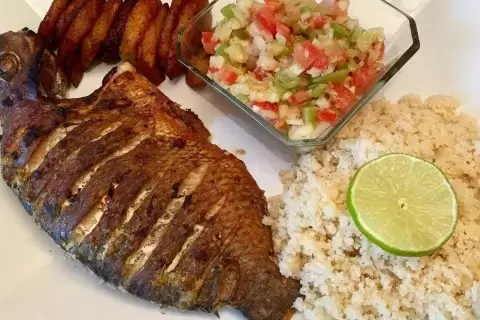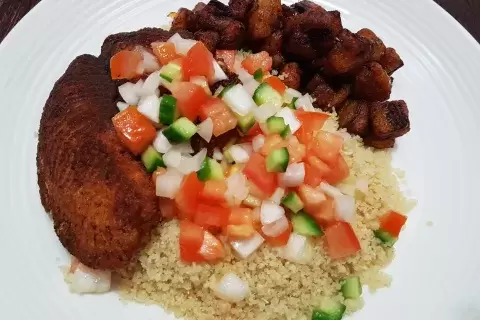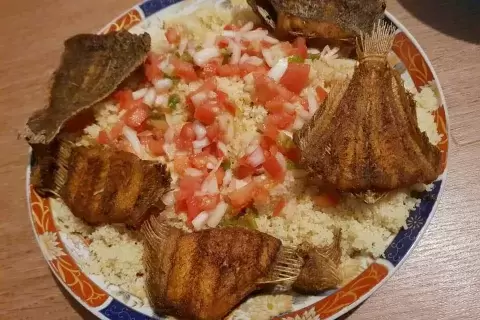Attiéké is a traditional dish from Côte d'Ivoire, a country located in West Africa. It is a staple food made from fermented cassava root that is grated, dried, and then steamed or boiled.
Attiéké has a unique texture, resembling couscous or small grains, and a slightly sour taste resulting from the fermentation process. It is often served as a side dish or a base for various meat or fish stews.
Attiéké is known for its versatility and is enjoyed by many for its light and fluffy texture, as well as its ability to absorb flavors from accompanying dishes. This popular Ivorian dish reflects the rich culinary heritage of the region and is appreciated for its distinct taste and cultural significance.
Introduction
Welcome to our food blog! Today, we're embarking on a culinary journey to West Africa to explore the delightful dish called Attiéké.
With its unique texture and savory flavors, Attiéké has gained popularity not only in its place of origin but also around the world.
Let's dive into the recipe and uncover the secrets to cooking this delicious and culturally significant dish.
Ingredients (serves 4-6)
- 2 cups Attiéké (cassava couscous)
- 1 ½ cups water
- 1 tablespoon vegetable oil
- 1 onion, finely chopped
- 2 tomatoes, diced
- 1 bell pepper, diced
- 2 cloves garlic, minced
- 1 teaspoon ground ginger
- 1 teaspoon paprika
- Salt and pepper to taste
- Fresh cilantro or parsley for garnish
Preparation
- Start by rinsing the Attiéké thoroughly in cold water. This process helps remove any impurities and excess starch. Drain well and set aside.
- In a large pot, heat the vegetable oil over medium heat. Add the chopped onion, diced tomatoes, and bell pepper. Sauté until the vegetables are soft and slightly caramelized.
- Stir in the minced garlic, ground ginger, and paprika. Cook for another minute to release the fragrant aroma.
- Add the water to the pot and bring it to a boil. Once boiling, reduce the heat to low and gradually add the Attiéké. Stir gently to combine and ensure all the grains are moistened.
- Cover the pot and let the Attiéké steam for about 10-15 minutes or until it becomes soft and fluffy. Stir occasionally to prevent sticking.
- Once cooked, fluff the Attiéké with a fork to separate the grains. Season with salt and pepper according to your taste preference.
Special Equipment
No special equipment is required for cooking Attiéké. However, a large pot with a lid and a fork for fluffing the grains will come in handy during the preparation process.
Serving Suggestions
Attiéké is a versatile dish that can be served with various accompaniments. Here are a few serving suggestions to enhance your culinary experience:
- Pair Attiéké with grilled fish or chicken for a traditional West African meal.
- Serve it alongside a vibrant salad made with fresh vegetables and a tangy vinaigrette dressing.
- Enjoy Attiéké as a side dish with a flavorful stew or curry.
Nutritional Value
Attiéké is primarily made from cassava, which is a root vegetable rich in carbohydrates and dietary fiber. It is also a good source of vitamins and minerals, including vitamin C and potassium.
As a staple in many West African diets, Attiéké provides energy and is often enjoyed as part of a balanced meal.
Cultural Value
Attiéké holds significant cultural value in West Africa, particularly in countries like Ivory Coast, where it originated. It is considered a national dish and is often served during special occasions and celebrations.
Attiéké has also gained popularity outside of Africa, representing the rich and diverse culinary heritage of the region.
Conclusion
Preparing Attiéké is an opportunity to savor the flavors of West Africa in your own kitchen. With its delightful texture, fragrant spices, and versatile serving options, this dish is sure to impress your taste buds and introduce you to a unique culinary tradition.
So, gather the ingredients, follow the recipe, and enjoy the rich cultural experience that Attiéké brings to your table. Bon appétit!
















